The engine was a boxer four-cylinder with fan forced ventilation coupled to the crankshaft, i.e. air-cooled. The luggage compartment was in the front compartment and had two full rows of seats. Ferdinand Porsche was involved in the design and development of the car. It was designed to be economical, practical and durable, with the idea of filling Germany with cars.
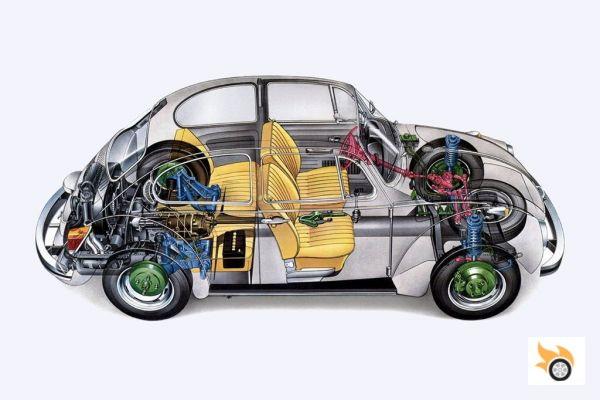
Porsche used the Beetle as the basis for its first production car in 1948. It was the prototype number 356, which eventually went on sale under the name 356. The idea was to build a sports car, and above all a reliable one. One of the people responsible for the product was Ferry Porsche, son of Ferdinand Porsche. To make it reliable (and not too expensive) the basis was the Type 1, a model already famous for its robustness and reliability.
They were based on the same engine and many Volkswagen parts originally, although over time they were getting rid of most of them. The chassis was lighter and the bodywork more aerodynamic. From 1948 to 1965 the power was increased from 40 to 130 hp. It was a great success for the brand, from 1948 to 1965 were sold 76,313 units.
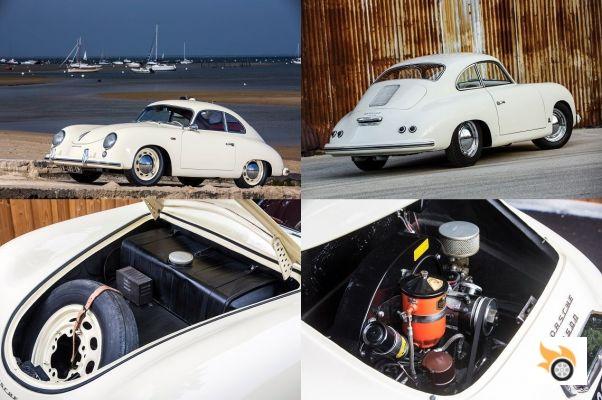
The 911 (901) appears in 1964 with a six-cylinder boxer engine, also air-cooled and starting from about 110 hp. Curiously it has six air-cooled cylinders, not two blocks of three, can be disassembled separately.
At the beginning many were those who took their hands to their heads, the 911 was bigger, heavier, more complex and with six cylinders instead of four, it couldn't be a real Porsche, with so many parts it would break as soon as it left the workshop! It was the first 100% Porsche model. All its parts were original Porsche parts, it no longer used any components from other vehicles.
It evolved as it grew in engine, performance and reliability. The 911 became the flagship car of the brand.
In this vehicle Porsche applied all the new technologies, among other things was the third passenger car with turbo engine in history, in 1974. Only after many years it changed to water cooling -another sacrilege for the authentic Porsche fans- and it was after the 928. It was a reference in terms of sports cars and also in terms of competition. Its entry into the sports car market was so important that Ferrari created the Dino series (later 308 and onwards) to compete with it.
It also has a very personal aesthetic that has survived to the present day.
The big drawback that Porsche found in this model is that it was really a sports car, all sacrificed for the sake of speed from its approach. This makes the car small, uncomfortable, impractical, with little equipment, hard suspension, hard steering and very sensitive to driving. It was evolution upon evolution of a model already anachronistic in the seventies, which dragged certain flaws from the beginning. For example, the rear engine does not cool as easily as a front one, you have to force the air to pass through the rear. Worse than that, is that being off the rear and being propulsion can make the car both oversteer and understeer. With good hands you can do wonders, but not inexperienced drivers (that 5% we were talking about the other day).
The current Porsche 911 (991) is a completely new car but retains two features of the original 911: rear engine layout and boxer six-cylinder.
Already in 1971, Porsche's management thought that if they created a fast and comfortable car they would sell the units they didn't sell of the 911 for the previous reasons. The idea of Porsche's first (and last GT) was born. The approach was very good.
Summary of the premises:
- It had to be comfortable and sporty, roomy enough for two people and two more or less large rear seats, with a useful boot.
- It had to comply with future anti-pollution, collision and sound regulations.
- It had to suit both the European and US markets
- Easy to use and maintain engine, with enough power to drive quickly
- Manual and automatic transmission
- Luxury interior finish
- Timeless, aerodynamic and genuine Porsche styling
- Always with Porsche quality and racing expertise
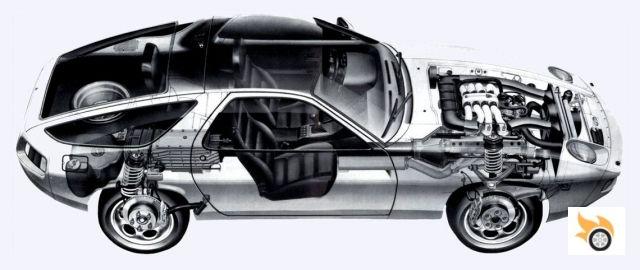
The development
It was an obstacle course that started at the end of 1971, when the project was initiated, and ended in early 1977. This development had two major problems. The first is that they came from a failed order from Volkswagen; a replacement for the Beetle called EA266, a rear-engined utility car that was never produced. For this reason they had little margin for error, they had to succeed. Even worse was the oil crisis of 1973, which was about to modify the whole project in 1974 or even cancel it, as we will see later.
Based on the above premises, ideas began to emerge and alternatives were presented. We have always said in these pages that the design of a car is to look for a compromise between all the available options. Here, with a high-performance sports car, a specific market niche, decisions also had to be made between several options to achieve the desired result.
It was a very thorough development from scratch - Porsche had never built a car like this before. The 924 was presented to the public in 76, a year earlier, but it was started in 1972, a year after the 928 was launched. What's more, the work already done on the larger model was used for the smaller model, not the other way around. The 924 was originally commissioned by Volkswagen with an Audi engine. Finally VW rejected it in 73 in favor of the Scirocco, more economical at the time. It was designed and sold by Porsche, production was contracted to Volkswagen.
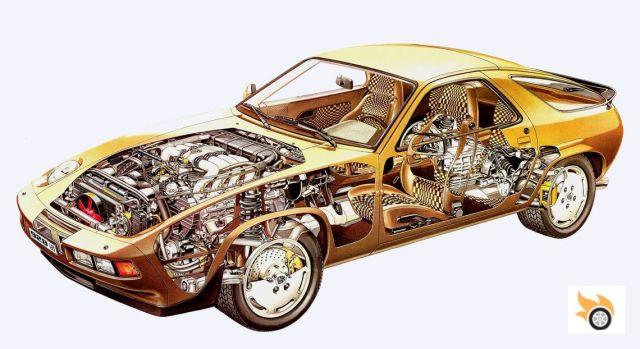
Engine
The displacement should be high. On the one hand, the car is a sports car, so it had to have enough power as such, also had to be able to be driven by anyone, with a very wide range of use. On the other hand, the implementation of catalytic converters was close, at that time it was like putting a sponge in the exhaust pipe. The power had to be enough in case the catalytic converter reduced it.
From the beginning, a water-cooled V8 with a light alloy block was considered. Why this change? Water-cooled to modernize the engine and reduce fan noise, and light alloy to avoid going over the scale, after all it is a sports car. The proposed displacement was five litres, with the option to increase or decrease by half a litre.
The decision came at the most unexpected place, the Yom Kippur War.
The project faltered at the end of 1973 and almost came to a standstill. At a time of gasoline shortages, it seemed that it didn't make sense to produce so many passenger cars, let alone GTs. Finally it was decided to hold on and continue with the project, although the engine was kept to a minimum. It started with a 4.5, two valves per cylinder and a camshaft in each V-block. The fuel supply was by K-Jetronic injection from the beginning and the first versions did not have a catalytic converter.
Years later this displacement was increased to 4.7, 5.0 (which premiered cylinder head with four valves per cylinder and double camshaft) and the latest version to 5.4. Power output climbed from 219 hp in the first version to 345 hp from 1992 with the 32-valve 5.4. The engine lived up to all expectations, those who have tested this car often comment the same. It has thrust from low to high revs, a very linear delivery. You can go in fifth gear at 50 km / h without any vibration with a car that passes 230.
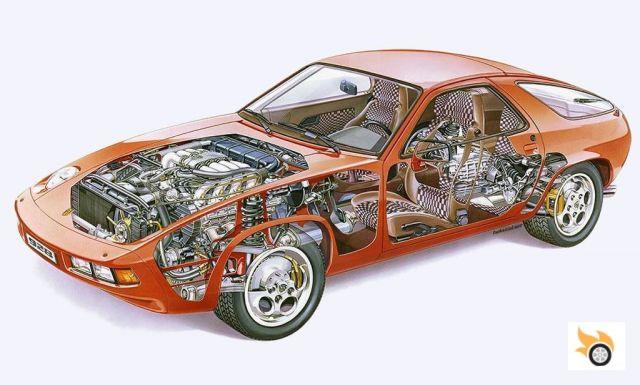
Chassis
This issue had more headaches. Mounting the engine in the rear was ruled out for several reasons, cooling was only one of them. A very sensitive issue was safety. A vehicle is more unsafe if the engine is in the rear, because it is difficult to absorb a hit by scope. We don't have room for programmed frame deformation (we now understand that increasingly long rear bumper of the 911). Another problem was the exhaust and catalytic converters, which would need more space.
The EA266 project was a utility car with the engine just under the rear seats. Not bad for a utility car, but a 5-litre V8 wouldn't leave room for a seat. The mid-engine wasn't satisfactory either, as the idea is for it to be a 2+2. It was thought that a GT with two child or "emergency" seats would be more popular in Europe than a strict two-seater. Finally it was decided to place it in the front compartment. However, this had other consequences. The nose had to be long and low to accommodate the engine and offer little section to the passage of air.
To balance the masses, it was decided to place the gearbox on the rear axle, passing a direct shaft from the engine to the gearbox rotating at the same speed as the engine. This configuration is known as transaxle, in this way we can balance the weight distribution, reaching a 50/50 in this case. When all the above seemed clear, the crisis of '73 broke out. In 1974 a vital decision had to be made about the project between three options:
- To stop it completely. That would be two projects stopped in a very short time and after three years of development.
- Keep it, but modify the configuration to four real seats with the idea of reaching a larger number of customers. It was necessary to change the chassis, appearance and focus on sales again. Many designs were made for four adults, even a prototype was built. No design could achieve the packaging and harmony of the 2+2.
- Keep it as is. It was the option that finally prospered, staying true to the original idea, although the engine was built down, as we have seen before.
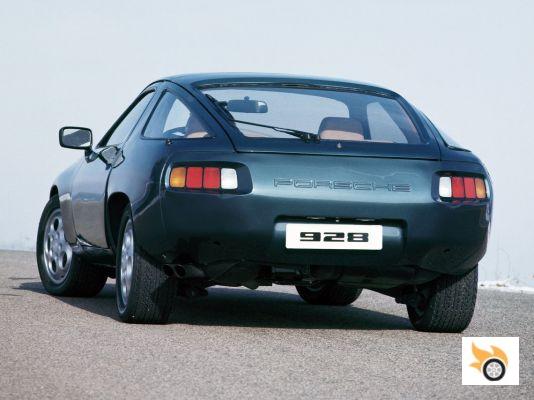
Suspension
One component that deserves a special mention is the rear axle, which Pablo already mentioned in his article about suspensions. I summarize: the rear suspension of the 928 is based on the semi-tired axle type, basically a rigid triangle in which the two points where it pivots are not parallel to the axis of the vehicle but have a rearward inclination. The problem that occurs in cars with a lot of power and rear propulsion is that if we brake or let off the gas in the middle of the curve, the outer wheel can open its angle because the rubber blocks that act as vibration isolators give way, and this makes the vehicle more oversteering.
The solution to the problem in competition is to put much stiffer rubber bushes, that way it doesn't move away from its angle. In competition it is a good solution, but it is not good for the back of the future owner. A lot of research was done to alleviate this tendency to open and what was done was to split the triangle in two. The front part was rigid and behaved as before, although a vertical pivot was added, so that it could tilt left and right in a controlled way. The rear part was elastic.
Thus, when braking or releasing the pedal mid-corner, we caused the wheel to close its angle, counteracting the natural oversteer of a rear-wheel drive and making it neutral. The axle was named Weissach, not after the town where they worked, but after the group of people who worked there.
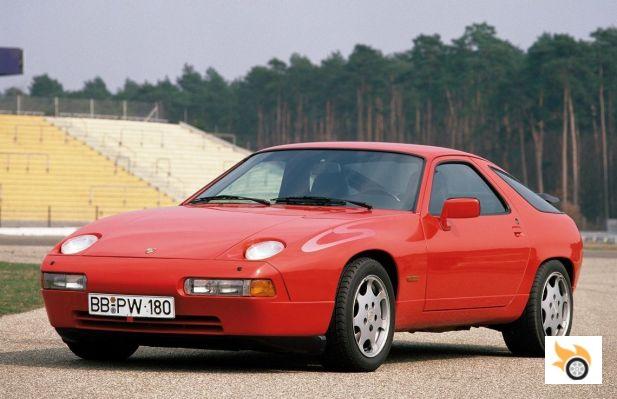
Design
The chief designer of Porsche at that time, Anatoli Lapine, and his assistant, Wolfang Mobius, were in charge of the design of the vehicle. Let's remember the three premises in the appearance of the vehicle:
- Timeless styling. From the beginning it was thought of a model with a long life, at least fifteen years.
- Porsche look, to identify it with the brand.
- Aerodynamic. For speed, stability and noise
For me they fulfilled the first two premises immediately. The aerodynamics were not very low at the beginning, it was 0.39. Years later, with the S4 it was lowered to 0.34, which is quite good considering it's a 70's sports car and the engine has to be ventilated a lot.
What was achieved from the beginning is a timeless line and a genuine Porsche style. Any connection to the wedge-shaped, angular lines, the new 70's thing, was discarded. Instead, it was given a rounded look, which has always reminded me of the rounded designs of the 60s. The latest versions with tweaked light clusters and more rounded bumpers are still in full force. Just think that the design of this model started 45 years ago!
As for the typical Porsche design, we have it everywhere. From the headlights always in view, the straight cut of the hood, the fall of the rear and the robust appearance, we see that we are facing a close relative of the 911. The exterior design is a coupe with a very modern line. The nose is flat with retractable headlights, curiously always in sight. The bumper was integral, rounded and plastic material, it seemed not to have them. In this way there is more freedom for the design and absorbs the blows better. It was all very new forty years ago, when the bumpers of similar vehicles were bars at the front of the vehicle, half black plastic, half chrome.
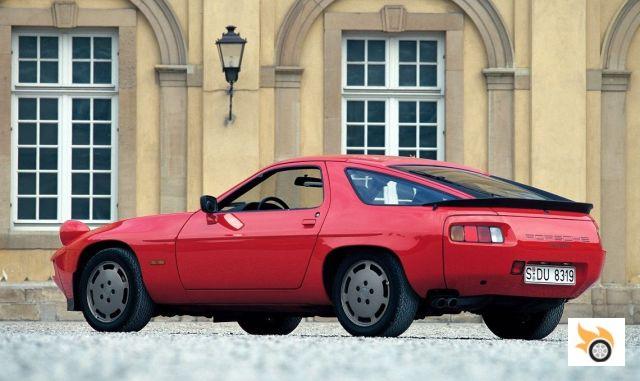
The upper line of the bonnet continues with the lower part of the windows, giving it lightness. It also has a line in the middle of the doors that gives it a certain dynamism. The side doors deserve a separate comment, they summarize the essence of the car. It is both independent and part of the A and B pillars, the B being very thick and inclined. The rear line falls gently down the C-pillar, which adds some more volume to balance the whole. The rear window is also reminiscent of the 911.
The wheel arches were enlarged as more powerful versions appeared.
We are left with the rear, the most personal part of the car. It is basically a flattened hemisphere, which gives it a very robust and compact touch. Another novelty was the fuel tank made entirely of plastic, taking better advantage of the gaps between the gearbox and the suspension. In this way it gave a little more space to the trunk.
And finally came to the street
It had available all the equipment of the time, both luxury and technological: leather seats, electric and memory. Having the drive shaft crossing the passenger compartment in a very low car with many sound insulators, made the line of the console very high splitting in two the passenger compartment. Something bland today, but at the time it looked like an airplane. In terms of technological equipment, it was one of the first cars to have ABS.
And its performance? The first version, the 4.5 16-valve, produced 219 hp, enough to propel the car to a top speed of 230 km/h and acceleration from 0 to 100 km/h in 6.8 seconds. The last version of 1995, 5.4 32 valves, went to 345 hp, 275 km / h and 5.7 s to accelerate, respectively. Compared to a 911 it was faster (except Turbo versions), but not only in acceleration and top speed; in some versions it was even faster in cornering. The weight varied from 1,450 to 1,620 kg.
It was presented at the Geneva Motor Show in 1977, it was an event.
There were mixed opinions, it was a Porsche, but it was not a 911. The same thing happened as when the 911 was presented and the 356 was discontinued. Some fans saw it as an outrage to Porsche's heritage. Others, on the other hand, saw the renewed spirit of the brand. It was European Car of the Year in 1978, the only sports car to do so. On paper it was a candy, especially for the US, spacious, comfortable, V8, fast, made in Germany, it had everything to be a sales success on paper; but the market said no.
From 1977 to 1995 just over 63,000 units were sold; not too bad, but it was not what Porsche expected.
What was wrong with this coupe for not falling in love? I certainly fell in love with it.
The Porsche 911 is one of the most recognizable cars in the world. That frog-eyed front end and droopy rear end are very recognizable. In addition, we can see the heritage from the Beetle. That is, we went from a cute car to a sporty, cool car. What happened to the 928? I remember some of my first automotive discussions were to defend the 928 against the 911, but they fell on deaf ears.
The 911 was still the brand image, plus it was the sports car, it wasn't for "cruising". Notice how typical is its image that the 911 is recognizable in all its versions since 1964 until today, after more than 50 years. We know it is a totally different car, but for any pedestrian is practically the same. Even its aesthetic features have been copied in today's Porsche SUVs. The Cayenne has that inspiration in the headlights over the hood, the Macan copies the headlights, air intakes, C-pillar drop and taillights.
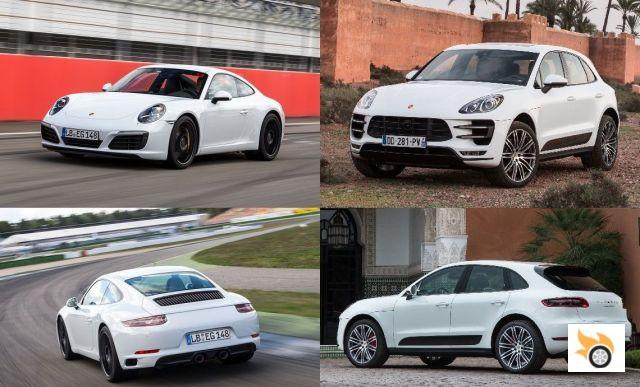
In the case of the 928, it had a very modern line at the time while maintaining the hallmark of Porsche.
Another problem was the price, higher than the 911 Turbo of the time, I remember seeing it in the sales lists for about 16 million pesetas.
Well, what do companies usually do to make a model more desirable? Besides making them cheaper and launching advertising campaigns they usually offer them as something special, for example, with a sportier touch. And how can you make a sports car to a car that already is? Or it was not a sports car, but a GT? I think Porsche made the big mistake here with the 928.
Without leaving Germany, if you wanted a very sporty car you could buy a 911, if you wanted a comfortable GT to travel without problems you had the Mercedes SL, if you wanted a big coupe to drive you had the BMW 635. The 928 was in an ambiguous place, it was neither the most comfortable, nor the fastest, nor the most effective, but it was very expensive. Plus, it was one of those typical cars that you have to explain to the general public what it is.
What I think Porsche should have done is explain to the public what it was with facts, that is, officially enter it in any race; then it would have become a real sports car. Ferrari did something like that with their GTs, it looked like they were getting gentrified and would only be good for cruising. So nothing, we lighten it, boost it, put an XXL spoiler, stickers and go racing. This way we always keep in mind that these cars are really sports cars.
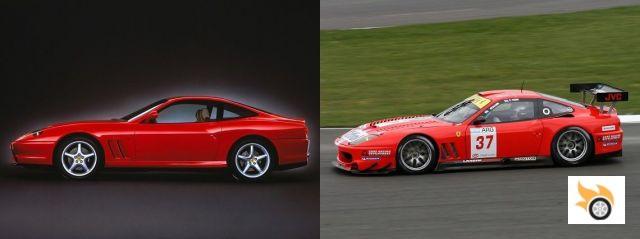
The 928 only participated in competition in a private team and the Weissach axle was not very well adapted for racing. Had it been an official team it would have been a great racing machine. And why am I so sure? If Porsche has continued to improve the 911 to remain one of the industry benchmarks with an anachronistic mass distribution even before the eighties, what could they have done from a better start?
Nobody has a crystal ball to know the future of a car's sales, because when it comes to buying a car, logic only tends to intervene once in the decision process, basically in that "I can't buy a car I can't afford", the rest is a personal decision. If we bought with logic, production of the old Fiat Panda would not have been discontinued and the Cinquecento would not have had a waiting list.
Worse still, although 18,579 units of the latest 911 have been sold this half year, the largest number of sales are the Cayenne and Macan SUVs, the Macan's share was 38% (45,086 units), an unthinkable success a few years ago. Another strange case is the Panamera, a four-door saloon, in many ways the opposite of Porsche's sports car philosophy, which became the brand's sales leader a year after its launch.
To sum up: the market rules, not logic.
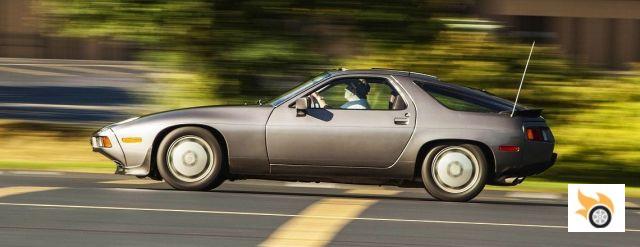
If you were in the eighties, with a budget of 15 to 16 million pesetas and you wanted to buy a German sports car, what would you buy: a luxurious coupe, fast and easy to use, spacious, with an acceptable trunk and the latest technology available, or an anachronistic, overpowered, small, uncomfortable, difficult to drive car with a line seen more than ten years before?
Well, gee, I was throwing the question out there to the non pistonheads. There simply seems to be no rival for the 911 within Porsche.

























